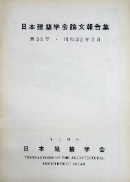Volume 177
Displaying 1-16 of 16 articles from this issue
- |<
- <
- 1
- >
- >|
-
Article type: Cover
1970Volume 177 Pages Cover1-
Published: November 30, 1970
Released on J-STAGE: August 22, 2017
Download PDF (55K) -
Article type: Cover
1970Volume 177 Pages Cover2-
Published: November 30, 1970
Released on J-STAGE: August 22, 2017
Download PDF (55K) -
Article type: Index
1970Volume 177 Pages Toc1-
Published: November 30, 1970
Released on J-STAGE: August 22, 2017
Download PDF (51K) -
Article type: Appendix
1970Volume 177 Pages App1-
Published: November 30, 1970
Released on J-STAGE: August 22, 2017
Download PDF (19K) -
Article type: Article
1970Volume 177 Pages 1-5,108
Published: November 30, 1970
Released on J-STAGE: August 22, 2017
Download PDF (532K) -
Article type: Article
1970Volume 177 Pages 7-13,108-109
Published: November 30, 1970
Released on J-STAGE: August 22, 2017
Download PDF (879K) -
Article type: Article
1970Volume 177 Pages 15-24,109
Published: November 30, 1970
Released on J-STAGE: August 22, 2017
Download PDF (1395K) -
Article type: Article
1970Volume 177 Pages 25-34,109
Published: November 30, 1970
Released on J-STAGE: August 22, 2017
Download PDF (1244K) -
Article type: Article
1970Volume 177 Pages 35-46,109
Published: November 30, 1970
Released on J-STAGE: August 22, 2017
Download PDF (1138K) -
Article type: Article
1970Volume 177 Pages 47-58,110
Published: November 30, 1970
Released on J-STAGE: August 22, 2017
Download PDF (1077K) -
Article type: Article
1970Volume 177 Pages 59-67,110
Published: November 30, 1970
Released on J-STAGE: August 22, 2017
Download PDF (433K) -
Article type: Article
1970Volume 177 Pages 69-78,110
Published: November 30, 1970
Released on J-STAGE: August 22, 2017
Download PDF (749K) -
Article type: Article
1970Volume 177 Pages 79-88,110
Published: November 30, 1970
Released on J-STAGE: August 22, 2017
Download PDF (1708K) -
Article type: Article
1970Volume 177 Pages 89-93,111
Published: November 30, 1970
Released on J-STAGE: August 22, 2017
Download PDF (671K) -
Article type: Article
1970Volume 177 Pages 95-106,111
Published: November 30, 1970
Released on J-STAGE: August 22, 2017
Download PDF (1237K) -
Article type: Appendix
1970Volume 177 Pages 107-
Published: November 30, 1970
Released on J-STAGE: August 22, 2017
Download PDF (18K)
- |<
- <
- 1
- >
- >|
